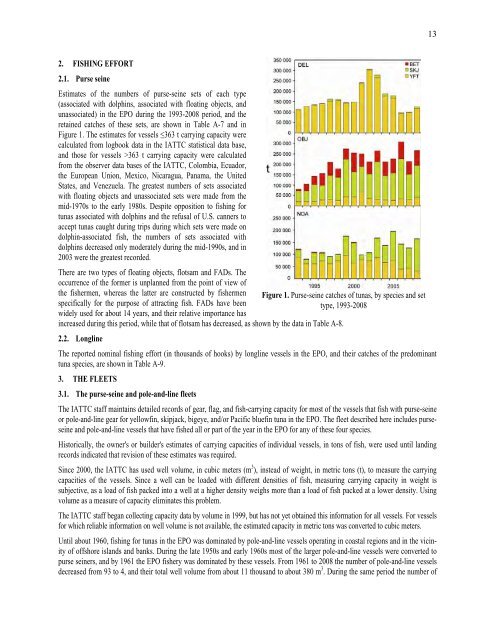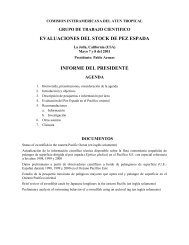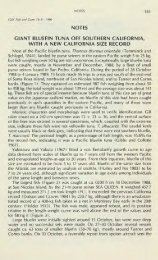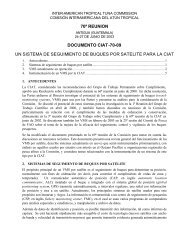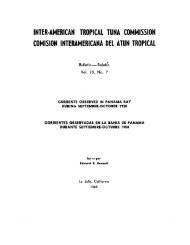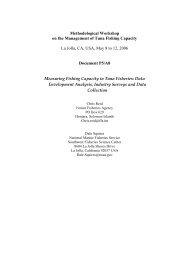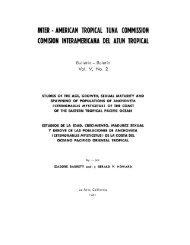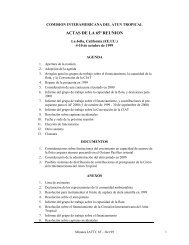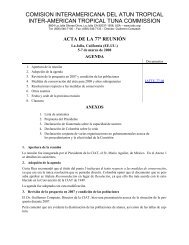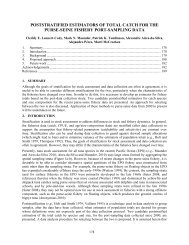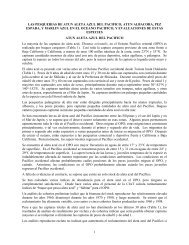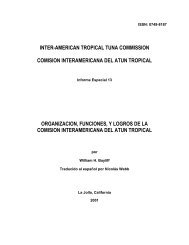INTER-AMERICAN TROPICAL TUNA COMMISSION - Comisión ...
INTER-AMERICAN TROPICAL TUNA COMMISSION - Comisión ...
INTER-AMERICAN TROPICAL TUNA COMMISSION - Comisión ...
- No tags were found...
You also want an ePaper? Increase the reach of your titles
YUMPU automatically turns print PDFs into web optimized ePapers that Google loves.
132. FISHING EFFORT2.1. Purse seineEstimates of the numbers of purse-seine sets of each type(associated with dolphins, associated with floating objects, andunassociated) in the EPO during the 1993-2008 period, and theretained catches of these sets, are shown in Table A-7 and inFigure 1. The estimates for vessels ≤363 t carrying capacity werecalculated from logbook data in the IATTC statistical data base,and those for vessels >363 t carrying capacity were calculatedfrom the observer data bases of the IATTC, Colombia, Ecuador,the European Union, Mexico, Nicaragua, Panama, the UnitedStates, and Venezuela. The greatest numbers of sets associatedwith floating objects and unassociated sets were made from themid-1970s to the early 1980s. Despite opposition to fishing fortunas associated with dolphins and the refusal of U.S. canners toaccept tunas caught during trips during which sets were made ondolphin-associated fish, the numbers of sets associated withdolphins decreased only moderately during the mid-1990s, and in2003 were the greatest recorded.There are two types of floating objects, flotsam and FADs. Theoccurrence of the former is unplanned from the point of view ofthe fishermen, whereas the latter are constructed by fishermen Figure 1. Purse-seine catches of tunas, by species and setspecifically for the purpose of attracting fish. FADs have beentype, 1993-2008widely used for about 14 years, and their relative importance hasincreased during this period, while that of flotsam has decreased, as shown by the data in Table A-8.2.2. LonglineThe reported nominal fishing effort (in thousands of hooks) by longline vessels in the EPO, and their catches of the predominanttuna species, are shown in Table A-9.3. THE FLEETS3.1. The purse-seine and pole-and-line fleetsThe IATTC staff maintains detailed records of gear, flag, and fish-carrying capacity for most of the vessels that fish with purse-seineor pole-and-line gear for yellowfin, skipjack, bigeye, and/or Pacific bluefin tuna in the EPO. The fleet described here includes purseseineand pole-and-line vessels that have fished all or part of the year in the EPO for any of these four species.Historically, the owner's or builder's estimates of carrying capacities of individual vessels, in tons of fish, were used until landingrecords indicated that revision of these estimates was required.Since 2000, the IATTC has used well volume, in cubic meters (m 3 ), instead of weight, in metric tons (t), to measure the carryingcapacities of the vessels. Since a well can be loaded with different densities of fish, measuring carrying capacity in weight issubjective, as a load of fish packed into a well at a higher density weighs more than a load of fish packed at a lower density. Usingvolume as a measure of capacity eliminates this problem.The IATTC staff began collecting capacity data by volume in 1999, but has not yet obtained this information for all vessels. For vesselsfor which reliable information on well volume is not available, the estimated capacity in metric tons was converted to cubic meters.Until about 1960, fishing for tunas in the EPO was dominated by pole-and-line vessels operating in coastal regions and in the vicinityof offshore islands and banks. During the late 1950s and early 1960s most of the larger pole-and-line vessels were converted topurse seiners, and by 1961 the EPO fishery was dominated by these vessels. From 1961 to 2008 the number of pole-and-line vesselsdecreased from 93 to 4, and their total well volume from about 11 thousand to about 380 m 3 . During the same period the number of


